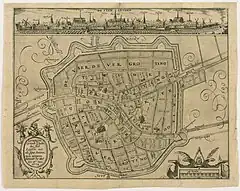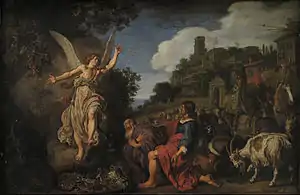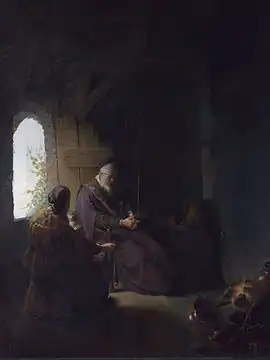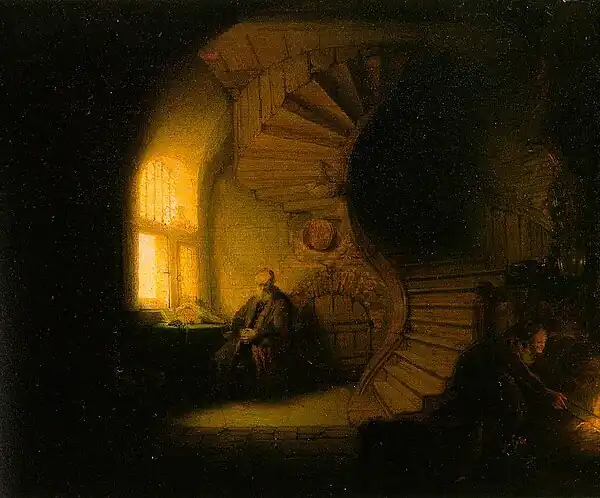Tobit and Anna with the Kid
Tobit and Anna with the Kid, also titled Tobit Accusing Anna of Stealing the Kid, and Tobit Praying for Death, is an early oil painting by the Dutch Golden Age painter Rembrandt, signed and dated 1626. It is now in the Rijksmuseum in Amsterdam.
| Tobit and Anna with the Kid | |
|---|---|
 | |
| Artist | Rembrandt |
| Year | 1626 |
| Catalogue | Bredius 486 |
| Medium | Oil on panel |
| Dimensions | 39.5 cm × 30 cm (15.6 in × 12 in) |
| Location | Rijksmuseum, Amsterdam |
| Accession | SK-A-4717 |
Subject
The subject of the painting is taken from the deuterocanonical Book of Tobit from the Old Testament.[1]
The painting showing the moment between Tobit and his wife Anna, early in the narrative, when the Tobit's faith in his wife's honesty is shaken. Tobit has been blinded in an accident, and to keep the family from poverty Anna works for the neighbours, for whom she makes cloth and sews clothes, and is paid in kind for her work. One day she receives a kid as wages and brings it home. Hearing the young animal's bleating, Tobit fears that his wife has stolen the animal and accuses her of committing a sin. Anna sharply denies the accusations, and Tobit begins to pray to God for death as release from suffering: "that I may be dissolved, and become earth".[2]
In the biblical narrative, the old couple's fortunes are eventually restored by their son, Tobias, with the aid and guidance of the angel Raphael, and Tobit is cured of his blindness by a magic fish caught by Tobias and Raphael in the Tigris.[1]
Description
The painting is signed, at lower left, "RH·1626".[3] This early work by Rembrandt, painted in the year he turned twenty, is described by art historian Gary Schwartz as "his first truly accomplished painting".[4]
Rembrandt skilfully tells the story, focusing on the most important threads: Anna, still with the goat at hand, has just heard her husband's accusation, which she indignantly denies. Tobit is deep in prayer to God, asking for death. At his feet is a small dog, symbolizing Tobit's fidelity and trust in God's justice.

Like most of Rembrandt's first Leyden period, the painting is rich in colour and human emotion.[3] For Michael Kitson, the work is an early and excellent example of Rembrandt's "lifelong fascination with old people".[1] The artist's mother may have posed for the character of Anna.[5]
Background
While the scene of Tobias and the Angel travelling through the desert was already an established subject in European art, Dutch Golden Age painters were also interested in the other episodes of the Book of Tobit.[1] Rembrandt's teacher, Pieter Lastman, had painted a scene from near the end of the story, The Angel Raphael Takes Leave of Old Tobit and his Son Tobias, in which Tobit and Tobias kneel in pious gratitude before the winged Raphael; and Rembrandt himself later painted Raphael's heavenward departure in The Archangel Raphael Leaving Tobias' Family.[1]
Sources


In painting the story of Tobit and Anna, Rembrandt relied on an engraving of the same scene by Jan van de Velde, engraved around 1620 after a painting by Willem Buytewech.[6]
Willem van Swanenburg's print of the penitent Saint Peter after a painting by Abraham Bloemaert has also been cited as a source for the figure of Tobit.[6] Indeed, Rembrandt repeatedly copied the work of other artists; he had many of them in his own private collection.[7]
Provenance
The painting was first mentioned on 29 October 1748 in the catalogue of Pieter van Buytene's collection (Oude Koornmarkt, Delft), which was put up for sale. Between 17 and 18 April 1759 it was purchased by Yver at an anonymous sale at an unknown auction house in Amsterdam. From 1905 to 1913 the painting was in the collection of Dmitry Shchukin (Moscow). In 1917, it was sold by the art dealer E. J. Goudstikker (Amsterdam), and it was in the collection of Baron Thyssen-Bornemisza (Schloss Rohoncz, Lugano; Villa Favorita, Castagnola) from 1956 to 1979. In 1979, the painting was acquired by the Rijksmuseum in Amsterdam.[3]
Related works
 Pieter Lastman: The Angel Raphael Takes Leave of Old Tobit and his Son Tobias, 1618
Pieter Lastman: The Angel Raphael Takes Leave of Old Tobit and his Son Tobias, 1618.jpg.webp) Abraham Bloemaert: Landscape with the Exodus of Tobias and the Angel, 1630
Abraham Bloemaert: Landscape with the Exodus of Tobias and the Angel, 1630 Rembrandt: Anna and the Blind Tobit, c. 1630
Rembrandt: Anna and the Blind Tobit, c. 1630 Rembrandt: Philosopher in Meditation, 1632
Rembrandt: Philosopher in Meditation, 1632 Rembrandt: Tobias Healing his Blind Father, 1636
Rembrandt: Tobias Healing his Blind Father, 1636 Rembrandt: The Angel Raphael Leaving Tobias' Family, 1637
Rembrandt: The Angel Raphael Leaving Tobias' Family, 1637 Rembrandt and workshop: Tobit and Anna with the Kid, 1645
Rembrandt and workshop: Tobit and Anna with the Kid, 1645.jpg.webp) Rembrandt: Tobit and his Wife (Tobit and Anna), 1659
Rembrandt: Tobit and his Wife (Tobit and Anna), 1659
See also
References
- Kitson 1982, plate 1.
- Tob. 2–3.
- Rijksmuseum.
- Schwartz 1985, p. 44.
- Kaufman 1981, p. 9.
- Schwartz 1985, p. 44.
- Michałkowa 1960, p. 21.
Sources
- Kaufman, Elizabeth Elias (1981). Rembrandt. New York: Book Sales. p. 9. ISBN 0-89009-372-5.
- Kitson, Michael (1982). Rembrandt. Oxford: Phaidon Press. pp. 15, 18, plate 1.
- Michałkowa, Janina (1960). Rembrandt. Warsaw: Wiedza Powszechna. p. 21.
- Schwartz, Gary (1985). Rembrandt: His Life, His Paintings. Viking. pp. 44, 47, 52, 230.
- "Tobit and Anna with the Kid, Rembrandt van Rijn, 1626". Rijksmuseum. Retrieved 20 April 2023.
Further reading
- Chudzikowski, Andrzej (1972). Rembrandt van Rijn. Warsaw: Wydawnictwo Ruch.
- Zuffi, Stefano (2011). Rembrandt. (Masters of Art). Prestel. ISBN 978-3-7913-4620-5.
- "Gerrit Willemsz. Horst". Netherlands Institute for Art History (RKD). Retrieved 20 April 2023.